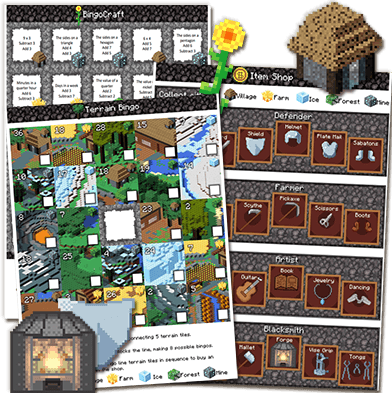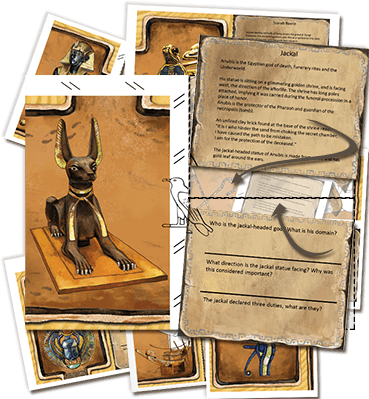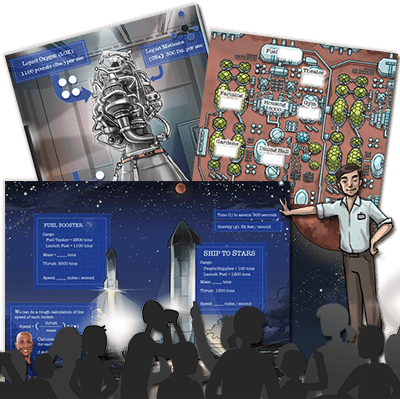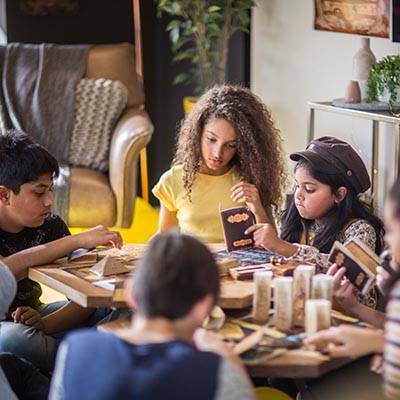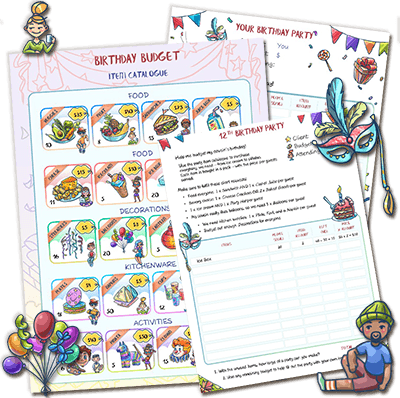Free Multiplication Tables Worksheets
Do your students need a little times tables practice? We've got you covered with these free printable worksheets!


This math worksheet gets kids invested in learning to budget. Sound impossible?! Check it out
For many students, multiplication is a step out of the kiddie pool and into deeper mathematical waters, and it can be a tough subject to teach if your students don't take to math naturally.
It's also one of those skills that simply requires lots of repetition and consistency. You may need to offer some extra guidance to help them get the concept down, and then to make sure they get enough practice to make it stick. We have a few tips on how to get your kids treading water comfortably in this part of the pond, and a free worksheet set to keep things swimming.
(When you're finished with those worksheets, check out our free math worksheet generator too).
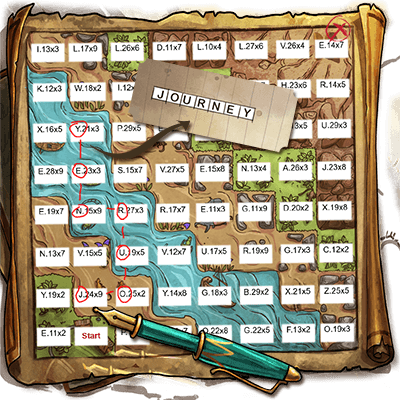
Ready to Level-up your math game?
These printable activity sheets instantly transform 'boring' math lessons into daring action-adventure treasure hunts!
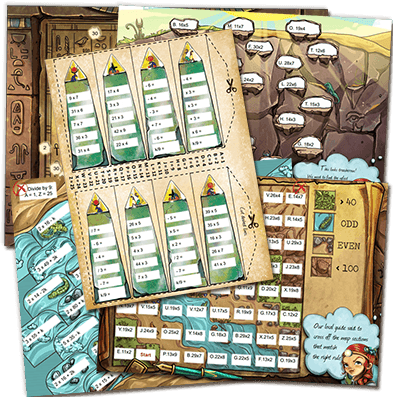
It All Adds Up

When we learn the multiplication tables, we gain a practical set of calculations for everyday life. Whether or not older students may be justified in grumbling that they will never need algebra or calculus when they're grown up, having a grasp of multiplication is indispensable.
This is especially true when it comes to organizing people and making sure they're all provided for! Whether it's for doubling a recipe, laying place-settings at a wedding reception, counting supplies for an archeological expedition into Ancient Egypt, or planting seeds in garden rows, multiplication is a skill that keeps our minds and our plans running smoothly.
While it's a conceptual step up from addition, multiplication is also a necessary piece of groundwork for more complicated math and STEM curriculum. Getting the basic multiplication tables down and developing confidence in working with larger figures allows us to understand more challenging concepts in higher learning, work, and the world around us.
Apart from the practical applications, we learn math because it helps to keep our minds sharp and get us through the patterns and puzzles of life with confidence and focus.
Need More Math Worksheets?

We know, you'll ALWAYS need more math worksheets...
So we've gone ahead and designed a worksheet generator to take care of all the heavy lifting for you. Just plug in how many problems you want on each sheet, the kind of math problems you'd like your students to solve, and you're all set.
Yep, that's infinite math worksheets for your classroom or homeschool lessons. All in one place, totally free. Now go get yourself a coffee, you deserve it!
The Times, They Are A-Changin'

Students may take you at your word that they have to practice skills to remember them, but even so, churning out worksheets under pressure can become a stumbling block if boredom and frustration lead to resistance. Recognizing that it might have value somewhere down the line won't help a child's mind turn what feels like drudge work into a rewarding activity on their own.
You may find that some take perfectly well to doing worksheets if the accomplishment of problem-solving is a good fit for them! They may be the exception rather than the rule, but letting them have the option to take a few and go to town will build their confidence better than surrounding the work with activities. If they already feel comfortable with the material, they may be more resistant if they think the activities are slowing them down or tricking them.
On the other hand, you may have students who struggle with the concept, or who struggle with applying it at speed. The sense of pressure that comes with a litany of problems to solve in a finite amount of time can more easily trip them up and cause them to absorb the idea that they're 'bad at math.'
If this comes up in your class, a little reassurance can show your students that you understand how their brains all work a little bit differently from each other, that it's okay if they need to work closer to their own pace, and that you want to help them find ways to figure it out. Teaching them to value their strengths and skills without putting themselves or others down is a lesson that's always ongoing, no matter the subject of the class or the age of the students.
Turn The Tables - Gamify learning

You can 'gamify' learning, using nothing but worksheets and your students imagination! Check out this worksheet game
When you find that no amount of drilling will help the idea to stick, finding ways to show your kids that these activities can be fun and worthwhile should go a long way to getting them to absorb the material. So, along with providing you with some printable worksheets to use in class, we also want to share some of our ideas for how to turn a block of problem sets into puzzles, games, and interactive challenges. These can work just as well in a homeschool environment as they do in a classroom.
Teamwork works!
We know that one of the best ways to learn something is to teach it, and letting students work together offers a lot of options, whether that's correcting a partner's work, exchanging problems like flash cards, or solving things as a group. They're able to learn the material while also practicing collaboration and exploring the idea from other angles, often extracting and providing the information rather than receiving it.
Break it up
One simple trick is to cut up the worksheets into strips or one problem at a time. You can put them in a box to take out at random, go over them in sequence as a class, or have the students do a few together and exchange them. Anything that keeps a bit of variety and surprise in the picture also keeps them from being intimidated by a blank page with lots to tackle.
Give them a hand
For some, the difficulty lies in connecting the idea of numbers as symbols to the idea of numbers as a collection of units. If you have students who are tactile or visual learners, keeping pictures, concrete examples, and sets of small items like buttons or beads will give them something to latch onto and aid their overall comprehension. You can work your way up to doing problem sets without them once the students are ready, but still have these aids available to fall back on if anybody needs a refresher.


Gamify it!
Math games pair well with making worksheets more interesting, and there are lots of options that can be adapted easily to suit your class.
- Matching games like Memory exercise several areas of the brain at once as students pair each half of the equation with its answer.
- Math Bingo is similar in theme and easy to tailor and vary as needed. You can call out the problems from the worksheet that you divided up individually, while the students find the answers on their card. Reversed, you call out the answers while the students try to match them to the problems. Either way, it's a good go-to game where the answers can be put together for results and or a recognizable sense of completion.
- For students who like to move around and get hands-on, you can try incorporating problems into a scavenger hunt, giving them a sense of sequence and accomplishment as the answers unlock each next step.
- Decks of numbered playing cards are handy to keep around for games like these because they come already equipped with visual units. One example is 'Multiplication War,' where students are paired off and each draws two cards per round, and multiplies their numbers. The hand with the higher result wins that round.
Factoring It All In

These games are helpful ways to practice, but they also emphasize comprehension and give students a chance to see how the calculations work, play with combinations, and find different options for getting to the answers. Allowing students to reason it out and figure out what makes the math tick gives them a chance to experience the 'aha!' moment, and that's one of the best ways to help the mind remember something. It also gives them agency in their own learning process, rather than making them feel shoe-horned into one 'right way' of doing things.
Give them a chance to explore how multiplication is full of fun quirks and patterns. For example, when you add the place values in a multiple of 9, the answer will always come out to 9 or another multiple of it. For example, 9 x 5 = 45, and 4 + 5 = 9, or 15 x 9 = 135, and 1 + 3 + 5 = 9. They can test this with different combinations and find that the rule works no matter how high the numbers go. This is a great first step in STEM curriculum to discovering further applications of their key math skills.
As mentioned earlier, multiplication is helpful in everyday life, so presenting real examples will help them recognize why they're learning it. Even better, you can let the kids come up with real examples on their own!
Your beads and buttons and any other hands-on methods that you have available can be easily worked into this idea. Egg cartons make great set holders to collect smaller units, and they're also a good way to work up to the challenge of multiplying by 12. You can work with the place-setting idea by arranging groups of seats in the classroom. Like the scavenger hunt, this activity encourages the more restless and energetic students to move around, rearrange things, and shake up their surroundings. Or you can have them assemble goody-bags for the class and figure out how many pencils, pennies, and treats go in each one.

The Final Product
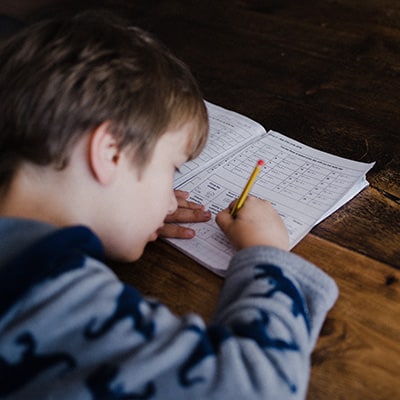
While we know it's tricky to tailor a lesson to individual learning styles, having a few different options and a flexible approach will let the kids know that you see them and are willing to work with them when they're struggling. Recognizing the likely stumbling blocks and re-orienting around them will keep the subject from becoming a much-dreaded chore for them and for you! If you focus on making it accessible and worthwhile, you'll keep them on-board no matter what materials and methods you use.
In the end, practice really does make perfect, so help yourself to our free worksheet pages! They're easily printable for you to use however you'd like. Hopefully, this helps you get your class (or eager homeschool kid) on their way to getting their multiplication tables down and ready to swim confidently into the deep end!
Ready to Supercharge Your Classroom?
These printable activities gamify your lesson to thrill students into learning.
Students will solve immersive puzzles, overcome critical-thinking challenges, and pull together as a team.
Each worksheet is designed to maximise fun, develop key skills, and do all the hard prep-work for you.
Printable Multiplication Facts Quizzes 1-12
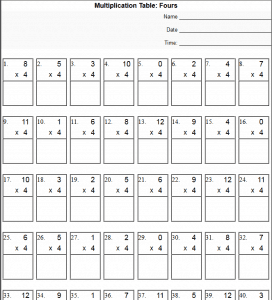
Multiplication Tables Worksheets - Free printable math worksheets. 1 - 12 multiplication tables as well as mixed multiplication facts.
CCSS.Math.Content.3.OA.C.7 Fluently multiply and divide within 100, using strategies such as the relationship between multiplication and division (e.g., knowing that 8 × 5 = 40, one knows 40 ÷ 5 = 8) or properties of operations. By the end of Grade 3, know from memory all products of two one-digit numbers.
